 |
|
President Uhuru Kenyatta addresses the nation. [PHOTO: FILE/STANDARD] |
By PAUL WAFULA
There is no economic or financial case for a new standard gauge railway in East Africa, a World Bank report says.
It is this report that informed the bank’s decision to back out from funding the project.
Instead, the bank, which considered four alternatives, preferred that Kenya should refurbish or upgrade the current line to a higher standard, using the same gauge.
“There is no economic or financial case for standard gauge in East African Community area at this time. A refurbished metre gauge would appear to be the most appropriate option in economic and financial terms,” the report prepared by the lender’s Africa transport unit reads in part.
The report, titled The Economics of Rail Gauge in the East Africa Community, is dated August 2013.
“Investment in standard gauge appears only to be justified if the new infrastructure could attract additional freight in the order of 20 to 55 million tonnes per year,” the report says.
But based on the traffic forecasts undertaken for the EAC railway master plan, it continues to say, and more recent work undertaken on the central line in Tanzania, these volumes would appear to be unattainable over the medium to longer term.
The Standard on Sunday has also learnt that the World Bank has already hired two consultants to study the current deal between Kenya and China in more detail to inform how it engages the country on future financing projects.
The report considered rehabilitating the existing network to the original standard gauge as the first development alternative. It also analysed refurbishing the current network to a higher standard, with the same gauge as the second option.
New right of way
The third alternative was for the region to upgrade the network to a higher standard, with a different gauge such as the standard gauge on the same alignment. Kenya chose the fourth option, constructing a new right of way from scratch.
A powerpoint presentation seen by The Standard on Sunday shows that Kenya had approached the international lender to negotiate a funding deal.
When he appeared before the Public Investment Committee, Treasury Cabinet Secretary Henry Rotich said Kenya did not get any other interested financiers, and this forced the Government to play by the rules of the Chinese Government.
According to the 2012 presentation by Transport PS Nduva Muli to the World Bank delegation, Kenya Railways wanted to build the Standard Gauge Railway using the American Standard, known as AREMA. But this changed after the funding came from China.
Stay informed. Subscribe to our newsletter
But sources familiar with the plan say the project, if viable, would attract less costly funding such as Build-Operate-Transfer, where the investor builds and operates the line at a profit to recoup their money, before handing it back to the Kenyan Government after an agreed timeframe.
According to its analysis, the first option – rehabilitating the existing railway network – would allow a phased approach to its development, consistent with current and projected demand and the financing envelope available. The report notes that this would represent the most cost effective option for the development of the railway infrastructure.
But it ruled this out because it would pose major capacity constraints given that the maximum amount of traffic that this could accommodate was 5.5 million tonnes per year, far below the 14.4 million tonnes of freight forecasted per year in the region by 2030.
The second alternative, which was preferred by the World Bank, would see the refurbishing or upgrading the railway network to the same gauge. This would imply a far more substantial intervention. But the report says that though this option would be more expensive upfront, it is still cost effective since it allows for re-use of materials and existing right of way and would have the capacity to deliver three times more than the required traffic volumes.
The third option considered was the upgrading the existing metre gauge to a standard gauge but sticking on the same alignment.
The report notes that this alternative would involve construction of a new railway along the same alignment. It would be more expensive but it is less costly than the construction of a standard gauge railway on a completely new alignment since it would save costs on land acquisition, among others.
Constructing a standard gauge railway on a new right of way is the fourth option explored in the report.
This option requires additional investment in land acquisition and structures, and new right of way construction. This is the alternative the Kenyan Government has chosen.
But what is more is that Kenya did not just pick on the most expensive option, but it will end up building the line at a much more costlier price than what World Bank had expected.
 The Standard Group Plc is a
multi-media organization with investments in media platforms spanning newspaper
print operations, television, radio broadcasting, digital and online services. The
Standard Group is recognized as a leading multi-media house in Kenya with a key
influence in matters of national and international interest.
The Standard Group Plc is a
multi-media organization with investments in media platforms spanning newspaper
print operations, television, radio broadcasting, digital and online services. The
Standard Group is recognized as a leading multi-media house in Kenya with a key
influence in matters of national and international interest.
 The Standard Group Plc is a
multi-media organization with investments in media platforms spanning newspaper
print operations, television, radio broadcasting, digital and online services. The
Standard Group is recognized as a leading multi-media house in Kenya with a key
influence in matters of national and international interest.
The Standard Group Plc is a
multi-media organization with investments in media platforms spanning newspaper
print operations, television, radio broadcasting, digital and online services. The
Standard Group is recognized as a leading multi-media house in Kenya with a key
influence in matters of national and international interest.









